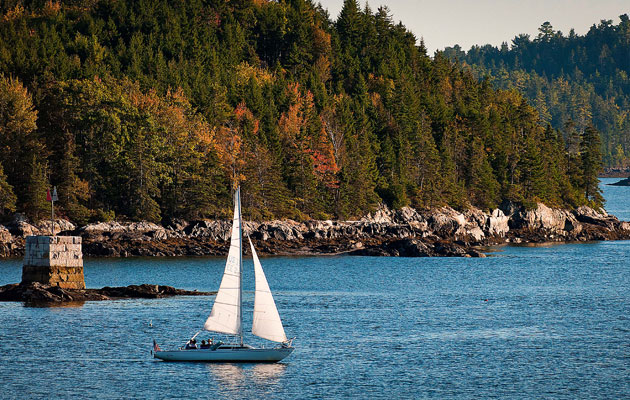Tom Zydler enjoys a late-September cruise through the fragrant inlets and rocky islets of Maine sailing in his classic Mason 44 Frances B
Sometimes you just get lucky. We left Cape Sable, Nova Scotia, astern and headed west, bringing the south-easterly wind onto a broad reach. We had about 130 miles to go to make landfall on Mount Desert Island. Sometime during the night the wind veered southerly and our Mason 44, Frances B, reached on smooth seas under a starry sky – unusually good conditions for Maine sailing. But this was the end of September when the clammy fogs of summer recede before the drier airs of autumn.
The scent of coniferous forests arrived on the light land breeze, which was just picking up. A massive bulk of high land heaved up ahead, underlined by a low, lighthouse-topped island just before it. Soon we entered Bar Harbor, slipping along past the 165ft four-masted schooner Margaret Todd, cleverly missing the tip of her bowsprit and tying up to a free float. A young, pretty harbour master punched some app on her iPhone and half an hour later we managed to convince the officer from US Customs and Border Control that we planned no mischief in Maine.
The shy dawn light was turning mauve when thunder ratcheted us out of our bunks – two cruise ships were just dropping anchor outside the line of yacht moorings. We rushed ashore in the dinghy in order to reach the farmer’s market before the tourists clogged the streets. America’s wealthy – Vanderbilts, Carnegies, Astors, Morgans and the like – used to hang out in Bar Harbor. Their ‘cottages’, the size of Aztec temples, line the shore of the harbour and the lingering aura of great riches still draw in summer visitors.
Frances B sailed west along the southern shores of Mount Desert Island. The trees were beginning to change to autumn colours – flaming red, orange, yellow. The hills climbed towards the 467m peak, the highest land on the west coast of the Atlantic until you reach Hispaniola Island in the Caribbean.
In bays indenting the island’s coast lobstermen’s houses overlooked their boats on moorings below. In Northeast Harbor fishermen have definitely lost ground to outsiders, affluent urbanites who escape the summer heat of the great American cities to the cooler coastal Maine. Mansions strutted along the shores and pretty sailboats bobbed on protected waters. It seems that in order to complete this version of the American dream the summer residents must also own a boat built by Hinckley – there were a lot of them.
We sailed into Southwest Harbor passing the Hinckley Boat Company compound on the south shore. A Hinckley 70, some venerable Bermuda 40s and a few Hinckley Sou’westers in a variety of sizes lay to moorings. Among them glistened Hinckley Picnic Boats – a type of pricey motor yacht based on the hull shape of the typical lobster boat.
Penobscot Bay, the largest body of water on this coast also has the most varied environment of islands large and small, winding passages, tight harbours and quiet towns. To reach it Frances B headed west again across the opening of Blue Hill Bay. Then, island-flanked Eggemoggin Reach took us on a slant to the north-west.
We had to beat, but in the lee of dense forests of fir, spruce and birch the water was smooth. Steering with light finger pressure on the wheel, we leaned back and relaxed. The lobster trap buoys that litter most of the sea in Maine had vanished. The crustaceans don’t like the muddy bottom in the Reach.
But let’s not forget that lobsters are the main crop here. In Castine harbour, pestered by strong currents and great depths, we picked up a mooring off Eaton’s Boat Yard. Little did we know that it came with a gift of live lobsters.
The town of Castine is old, predating Plymouth colony by a few years. It began as a fur trading post and then became desirable as a source of timber for navy ships. In 1779 the newly independent Massachusetts sent a fleet to chase the British out. Owing to a bumbling naval commander, the Penobscot Expedition lost 41 vessels and hundreds of men to the British. In US naval annals it counts as the worst loss before Pearl Harbor.
While Castine was quiet, Camden across the bay on the western shore of Penobscot was humming. The inner harbour was packed tight with yachts. Schooners were still coming to their customary wharves, many without auxiliary power, helped in manoeuvring by a small motorised ‘yawl boat’ they towed.
Considering the small size of the town, a staggering numbers of vessels hit the water here – 70 of them from just one yard, owned by Joseph Stetson, who opened in 1816 and carried on for 40 years. Faced with labour problems he invented the ‘coffee break’, now a hallowed employee perk the world over!
We had our mind set on a visit to Monhegan Island, about ten miles off the mainland. It figures prominently in the history of exploration. Southerly winds and swell make its anchorage untenable, so when a north-easterly came we charged down the west coast of Penobscot Bay, on past Owl’s Head and squeezed through Muscle Ridge Channel. Ahead on the clear horizon Monhegan bulked up its whale-back silhouette.
This is an extract from a feature in Yachting World August 2014 issue




